Two sets of photographs are required that
include life-size profile photographs. (Your can determine your
camera's life-size distance setting by photographing a ruler at
various distances and comparing photo and object sizes.) Acetate
sheet overlays are fixed to the photographs for marking
lines.
The photo planning of an early Template Rhinoplasty
|
|
| The initial planning is on both of the full
face profile photographs moving the tip to a new position
according to dynamic forces resulting from the
superficial depressor septi muscle, the elastic fibres in the
membranous septum, the length of the lateral alar ligament and
septal support if a tension nose (bridgeline forward of the
tip). |
 |
| Mask the profile reduction on one photograph
to illustrate the changes. The other photograph is used for
copying the data to the life-size photograph. |
 |
| Transfer the new profile data to the
life-size photograph (which shows the forehead, nose and
upper lip) as follows: |
|
| Mark reference lines on the life-size
photograph: forehead key, tip break point, septal caudal edge,
septal incision and reference, lateral alar ligament. |
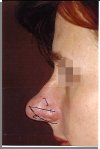 |
| Trace tip profile and reference marks on a free
acetate sheet. Place the free sheet under the acetate
overlay and reposition the tip complex according
to initial full face plan. |
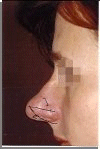 |
| Mark the new positions for the tip profile
and reference lines on the fixed acetate sheet. |
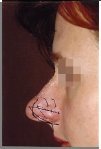 |
| Mark new bridge line. |
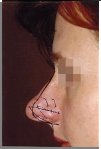 |
| Copy to a polycarbonate sheet and cut out the
template. |
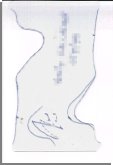 |




